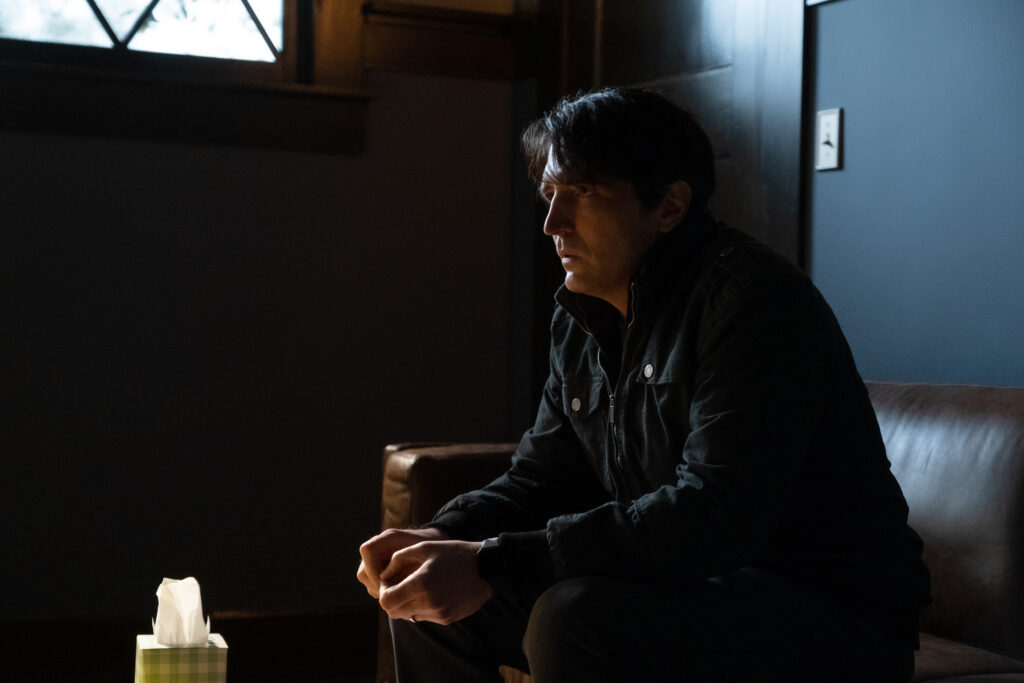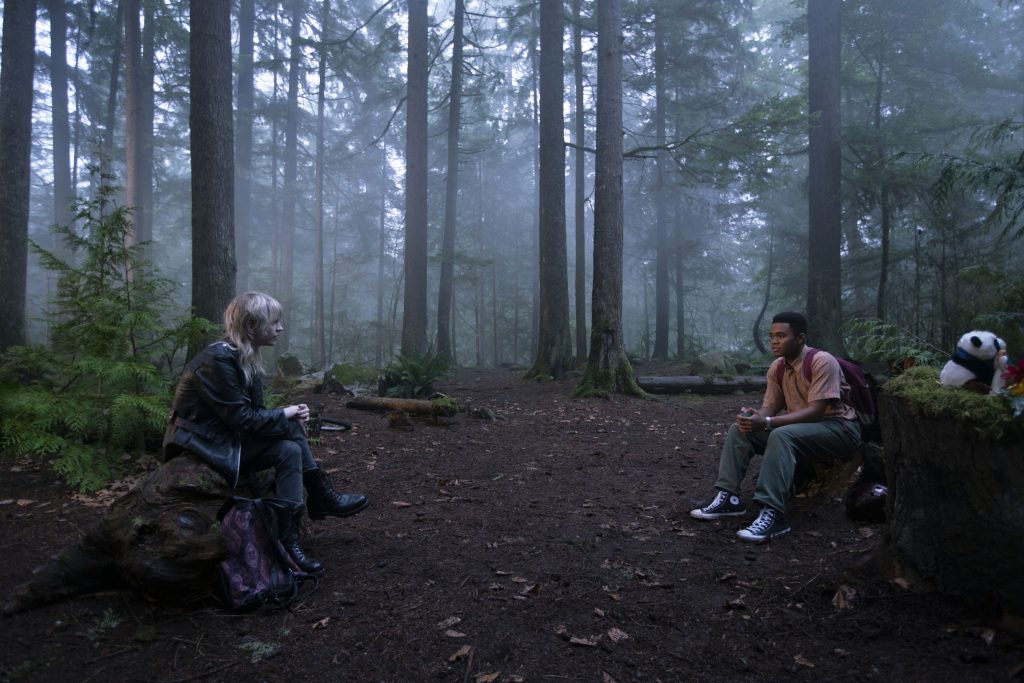May 29, 2023
by Carla Hay

Directed by Rob Savage
Culture Representation: Taking place in New Orleans, the horror film “The Boogeyman” (based on a short story by Stephen King) features a predominantly white cast of characters (with a few African Americans and Asians) representing the middle-class and working-class.
Culture Clash: A 16-year-old girl and her 10-year-old sister experience an evil creature in their home after their mother dies, but their therapist father doesn’t believe his daughters.
Culture Audience: “The Boogeyman” will appeal primarily to people who are fans of Stephen King and unimaginative horror movies filled with a lot of clichés.

Dull, dimwitted, and very derivative, “The Boogeyman” offers minimal scares and has too many scenes of people talking about certain horrors and not enough scenes actually showing those horrors. The movie’s last scene is very weak and underwhelming. The majority of “The Boogeyman” is literally a back-and-forth slog of two underage sisters (separately or together) looking frightened in dark rooms and then trying to convince their skeptical father that they’re being haunted. And when the evil creature they see finally does appears in full view, it’s just more of the same type of showdown that’s been in countless other horror movies.
Directed by Rob Savage, “The Boogeyman” is based on Stephen King’s short story that was first published in the March 1973 issue of Cavalier magazine, and then republished in King’s 1978 short-story collection “Night Shift.” King’s “The Boogeyman” (which had only three characters) had a much better ending than the formulaic dreck that’s in “The Boogeyman” movie, whose screenplay was written by Scott Beck, Bryan Woods and Mark Heyman. “The Boogeyman” movie adds several characters to give the story enough for a feature-length film. But the additions do not bring any creativity to the story. Everything is a rehash of many other horror movies about an evil creature or spirit that’s haunting a household.
In “The Boogeyman” short story, the only characters were a psychotherapist named Will Harper, his client Lester Billings and The Boogeyman. The story took place in one setting: Will’s office, during a therapy session between Will and Lester. Will has a wife and kids, who are mentioned in the short story, but these other Harper family characters do not appear in the story.
In “The Boogeyman” movie (which was filmed on location in New Orleans), Will Harper (played by Chris Messina) is a supporting character, while his two daughters are more of the focus. The main protagonist is 16-year-old Sadie Harper (played by Sophie Thatcher), a moody introvert. The main location in the movie is the Harper house, where Will has his therapist office. Sadie and her inquisitive 10-year-old sister Sawyer Harper (played by Vivien Lyra Blair) live there, but Will is a widower in the movie. It’s mentioned that Will’s wife (the mother of Sadie and Sawyer) died fairly recently in car accident.
Viewers know the death is recent because early on in the movie, Sadie is shown at her high school (in one of several scenes that take place at the school), and many of the students react to her like someone who’s just come back from a brief hiatus. On her first day back at school since her mother’s death, Sadie is wearing one of her mother’s dresses. And (cliché alert) a group of “mean girls” bully Sadie about it near her locker.
The leader of the mean girls is a snooty blonde named Natalie (played by Maddie Nichols), who says the most to make Sadie feel bad about Sadie’s choice in clothing. When Sadie tells Natalie, “You’re being a bitch,” it leads to a tussle, where Sadie gets shoved hard against her locker. The only student at school whom Sadie considers to be a close friend is Bethany (played by Madison Hu), who sticks up for Sadie whenever she can.
Back at home, the Harper family members are dealing with their grief in different ways. Will has become more caught up in his work and more emotionally distant from his daughters. Ironically, even though Will is a therapist who’s trained to help people with things such as grief, he’s avoiding helping his own daughters process their own grief. Instead, Will has hired a therapist named Dr. Weller (played by LisaGay Hamilton) to counsel Sadie and Sawyer.
Sadie would rather talk to Will about how to cope with her mother’s death, but Will tells Sadie to talk to Dr. Weller about it instead. This rejection causes Sadie to feel more alienated and depressed. Sawyer clings to Sadie for emotional support, but Sadie is barely hanging on to feeling like she’s capable of functioning in the way she used to before their mother died. And things are about to get worse when Sadie and Sawyer find out that their house is haunted.
One evening, when Will has seen his last client of the day, a mysterious stranger shows up unannounced at the house. His name is Lester Billings (played by David Dastmalchian), and he asks Will if he could have a therapy session. Will tells Lester that he doesn’t give therapy to a new client without a phone consultation first. However, Lester pleads for Will’s help. Lester looks so sad and desperate that Will agrees to make an exception for Lester.
During the therapy session, Will asks Lester to tell more about himself. Lester says that people think that Lester killed his wife and kids, one at a time, even though Lester says he’s not guilty. Lester says his first child was a baby girl who died of sudden infant death syndrome. Lester and his wife had two other kids.
And then, the conversation gets weirder. Lester says that he glimpsed “it” before one of his children died of a broken neck. Lester shows Will a drawing that Lester made of the creature that Lester says he saw. Lester says to Will: “It cares for your kids when you’re not paying attention.” By this point, Will has gotten freaked out by this conversation, so he excuses himself, goes in another room, and calls the police to report that a potentially dangerous man is in his home.
Meanwhile, Sadie has come home, and Will tells her to go to her room because there’s a stranger in the house that Will needs to have removed. Will goes back in his office, but Lester isn’t there. A frantic Will searches for Lester in the house. Sadie hears noises that sound like two people are fighting in her bedroom. When she looks in her bedroom closet, she sees Will dead, from an apparent suicide by hanging.
None of this is really spoiler information, because the main things that keep happening in “The Boogeyman” movie are typical “shadows and bumps in the night” scenarios, where Sadie and Sawyer are in dark or barely lit rooms (apparently, the Harper family doesn’t know the meaning of having good overhead lighting), where they hear or see something strange, but when they investigate further, it appears to be nothing but their imagination. When Sawyer and Sadie tell Will, he doesn’t believe them.
Sawyer has a glowing orb that’s the size of a bowling ball, which she uses as lighting in a dark room, instead of doing what most kids would do if they’re frightened in a dark room: Turn on a room light. But no, Sawyer doesn’t do that. Instead, she rolls this glowing orb on the floor, like she’s a paranormal bowler, but with no bowling pins.
And predictably, wherever the orb stops on the floor, you know it’s going to be right where something “scary” is. Seriously, this glowing orb is not even remotely believable as a toy that most 10-year-old girls would want to have, let alone use as a way to see in a dark room. It’s one of the many phony-looking things about “The Boogeyman,” which lumbers along at a glacial pace and fills up a lot of time showing scenes of mopey Sadie being a social outsider at her school.
As already revealed in the movie’s trailer, when Dr. Lester does some strobe-light therapy on Sadie and Sawyer, the girls both see The Boogeyman, but Dr. Lester doesn’t see this creature. The strobe-light therapy looks like a very questionable thing for a therapist to do to emotionally fragile children. There are long stretches of the movie where Will is not seen at all in the Harper household, even though he works from home. Will’s absence is never explained. It’s just more of this movie’s phoniness on display.
There’s a subplot in “The Boogeyman” about Sadie being an amateur sleuth to find out more about Lester, which leads to some not-scary-at-all flashbacks/visions involving Lester’s wife Rita Billings (played by Marin Ireland). A better movie would have had the creepy character of Lester in a lot more scenes, instead of killing him off so early in the movie. The performances in “The Boogeyman” aren’t terrible, but they aren’t anything special, and they certainly don’t do much to elevate this very drab and slow-paced movie.
“The Boogeyman” was originally going to be released directly to Hulu (and other Disney-owned streaming services outside the U.S.), but those plans were changed after horror movies such as Paramount Pictures’ “Smile” and 20th Century Pictures’ “Barbarian” became hits in movie theaters in 2022, after these horror flicks were originally planned to be released as direct-to-streaming movies. (20th Century Pictures, the theatrical distributor of “The Boogeyman,” is owned by Disney.) “The Boogeyman” might satisfy viewers who want the most basic, run-of-the-mill horror movie that’s mild on scares. But considering how the movie’s ending is such an inferior (and overly formulaic) departure from the original short story, “The Boogeyman” will just leave a lot of viewers feeling disappointed instead of satisfyingly terrified.
20th Century Pictures will release “The Boogeyman” in U.S. cinemas on June 2, 2023.


